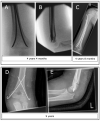Intrainstitutional Changes of the Treatment of Supracondylar Humerus Fracture in Children over a Period of 9 Years
- PMID: 38255341
- PMCID: PMC10814588
- DOI: 10.3390/children11010027
Intrainstitutional Changes of the Treatment of Supracondylar Humerus Fracture in Children over a Period of 9 Years
Abstract
To assess changes in treatment modalities for supracondylar humerus fractures (SCHFs) at a large pediatric university hospital, we analyzed patient data from 2014 to 2022. A total of 233 SCHFs treated surgically at our hospital were included. To evaluate postoperative outcome and quality of life, DASH and EuroQol-5D-Y questionnaires were sent to patients. In addition to a significant fluctuation in fracture severity, we found an increase in training interventions (more surgeries were performed by trainees) and a significant decrease in surgery times after 2016. From 2020, there was a significant shift in the type of surgical method away from closed reduction with elastic stable intramedullary nailing (ESIN) and towards closed reduction and crossed K-wire osteosynthesis (CRK). Surgeries performed in the morning and evening hours increased, while those performed in the afternoon and after midnight decreased. After a mean follow-up of 4 years, there was no difference in elbow function between ESIN and open reduction and K-wires (ORK). Treatment with ESIN was equivalent to ORK in terms of function, at least in the medium-term follow-up. In summary, the combination of shifting treatment from SCHF to daytime hours, increasing trainee participation and using cross K-wire fixation instead of ESIN had no negative impact on surgery times. In our setting, these measures have reduced resource utilization and increased efficiency without compromising patient care.
Keywords: elbow fractures; fracture fixation; hospitals; intramedullary; learning curve; operative time; quality of life; retrospective studies; university.
Conflict of interest statement
The authors declare no conflict of interest.
Figures






References
-
- Cheng J.C., Lam T.P., Maffulli N. Epidemiological features of supracondylar fractures of the humerus in Chinese children. J. Pediatr. Orthop. B. 2001;10:63–67. - PubMed
LinkOut - more resources
Full Text Sources

